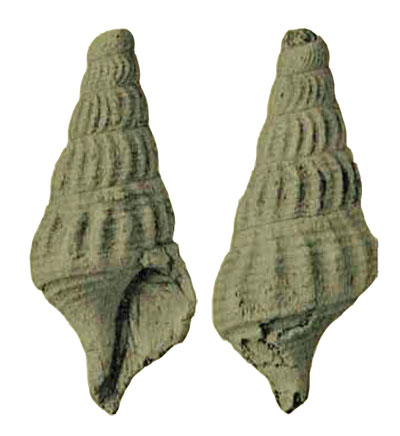Original description of Anchura bexarensis by Stephenson, 1941, p. 297:
- “Shell of moderate size, turreted, apical angle about 30 degrees. Suture closely appressed, moderately impressed. Whorls 5 in the incomplete holotype, slightly convex on the sides, a little constricted posteriorly below the suture on the larger whorls. The axials are of moderate thickness and prominence, but are narrower than the interspaces; on the largest whorl the axials number 15 and on successively smaller whorls respectively 18, 20 and 24. As in other similar species the trend of each axial forms a curve broadly concave toward the aperture; on the largest whorl the axials end abruptly at the periphery. On each of the larger whorls are 8 primary revolving ridges which override the axials; the still smaller spirals are not very clearly preserved but in each interspace is one, or in the wider ones two, secondaries, and in places tertiaries can be detected in the smallest interspaces. The periphery of the largest whorl, which presumably is the body whorl of an immature specimen, is subobtusely angular and the base descends steeply to the columella; on the base are 4 or 5 widely spaced, primary revolving ridges which become successively smaller from the periphery downward, and in the interspaces are numerous fine riblets which are not clearly preserved. The aperture is moderately wide but is somewhat elongated, and passes anteriorly into a siphonal canal whose anterior portion is broken away and is therefore of undetermined length.”
Locus typicus: West of Zuehl, Guadalupe County, Texas, USA
Stratum typicum: Kemp Clay, Navarro Group, Maastrichtian, upper Cretaceous
Type specimens: Holotype USNM no. 76906: height 37+ mm, diameter 16.5 mm; one paratype, no. 76907.
Original comment by Stephenson, 1941:
- "In the matrix with the holotype was found the apical portion of a shell, probably this species, with the protoconch and 3 or 4 additional whorls, all poorly preserved. The axial sculpture on the two larger whorls is fine and closely spaced and traces of fine revolving ridges may be seen. The protoconch is small and apparently simple."
Anchura bexarensis (holotype) Stephenson, 1941, pl. 55, figs. 4, 5
- Image courtesy The University of Texas at Austin
References:

